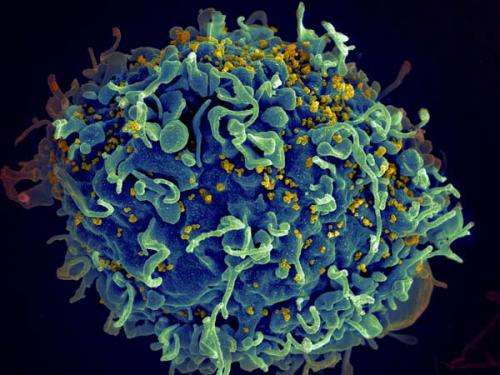Blood T cells are resistant to HIV's primary death pathway

Scientists from the Gladstone Institutes have discovered that blood-derived T cells are resistant to the chief cause of cell death in HIV infection. Instead, it is T cells in the lymphoid tissues that are most susceptible and whose death leads to the progression from HIV infection to AIDS.
While 98 percent of CD4 T cells are in the lymphoid tissues, almost all prior studies on HIV have been conducted using blood cells. The scientists say the latest findings, published in the journal Cell Host & Microbe, should spark greater use of lymphoid tissue T cells to study the pathogenic effects of HIV. Blood cells, which are easier to obtain, do not recapitulate all of the key biology of lymphoid tissue cells.
"These results drive home that HIV is a disease of lymphoid tissues, not blood," says senior author Warner C. Greene, MD, PhD, director of the Gladstone Institute of Virology and Immunology. "As such, greater emphasis must be placed on studying HIV infection within these lymphoid tissues; that's where the virus is replicating and spreading. Over the past 30 years, scientists have largely studied HIV using blood cells because of ease of acquisition, so there may be significant, fundamental biology that we've missed. For example, if we had restricted our research to blood-derived cells, we would have missed primary cell death pathway operating during HIV infection."
Previous research from the Greene laboratory revealed that the main cause of cell death in HIV involves a programmed cell death pathway called pyroptosis, where the cells commit a particularly fiery form of suicide in self-defense to prevent the spread of the virus. When the virus invades a cell that is "at rest," the infection is aborted. However, fragments of viral DNA accumulate and are detected by the resting host cell through the sentry protein IFI16. This triggers a domino effect in the cell's defense system, resulting in the initiation of pyroptosis.
Remarkably, blood CD4 T cells are resistant to this death pathway, in part because the cells are in a deeper state of rest, meaning the virus is unable to infect them completely, which prevents the onset of the chain of events that leads to pyroptosis. Additionally, the blood cells have less of the enzyme IFI16 that detects viral DNA fragments in the cell.
"Because the blood cells both accumulate less viral DNA and express less IFI16, there is nothing to be 'sensed' and nothing to sense it with," says first author Isa Munoz-Arias, PhD, a postdoctoral researcher at the Gladstone Institutes. "Together, these findings indicate that only small amounts of viral DNA accumulate in the cell, so the virus remains undetected. As such, the pyroptotic response never occurs."
In a curious twist resembling cellular alchemy, when blood T cells are cultured with lymphoid tissue from the tonsils or spleen, the blood T cells begin acting like lymphoid tissue T cells, becoming more activated and more susceptible to abortive infection and death by pyroptosis. Thus, blood cells can become sensitive to this death pathway if they come into contact with lymphoid cells, as would occur when blood CD4 T cells traffic into lymphoid tissues. Based on this finding, the researchers believe there must be a signal from the lymphoid tissue cells that influences the blood T cells when they are cultured together, causing the blood cells to behave like lymphoid tissue cells.
However, when the blood cells were separated from the lymphoid tissue, they regained their resistance to pyroptosis. These findings suggest pyroptosis sensitization requires continuous cell-to cell signaling between the lymphoid tissue and blood T cells, and sensitivity is rapidly lost when this signaling is interrupted.
The scientists report that the next step is to identify this cell-to cell signal and attempt to block it using small molecules. Successfully doing so could instill lymphoid T cells with the same immunity to pyroptosis found in blood T cells, potentially rendering the body resistant to cell death by HIV. What's more, the discovery of such a fundamental difference in the biology of blood and lymphoid tissue CD4 T cells opens the door to retesting drugs in lymphoid tissue that were deemed ineffective in blood cells. This might be particularly important in the HIV Cure research arena.



















